THE EARTHSHIP HUT BUILD: DAYS 2-5. Why tyres make the ultimate eco-building material and how to build with them
Today I would like to explain just why Earthships work SO well, and give a bit more detail about building tyre walls. The first week or two of any small Earthship build is mostly concerned with tyre ramming and some void packing of the walls with mud. This knowledge is one of the most important aspects of Earthship construction in terms of an Earthships performance and durability. Luckily, building a house from tyres is WAY less technical and complected than any traditional brick and mortar build.
We had a team of around 20 volunteers with a few Nepali helpers as backup. Whilst almost no one except for @nature-jon and I knew anything about building, we were able to explain and demonstrate everything as we went along. It doesn't take long to explain the basics to people, and we were able to visit each person as they were working to check and make any adjustments if needed. The basic premise of tyre ramming is that you are using an old steel belted rubber tyre to encase and entomb a heck of a lot of dirt, a lot more mass then just about any other kind of wall. The dirt is beaten into the tyre using a heavy sledge hammer, without adding water unless the dirt is bone dry. Note that this is different from other techniques such as cob and earth-bag construction since we don't add water and let it set. When dirt is compacted to 96% it is rock solid, and is much stronger than cob, concrete an just about anything else! Tyre walls are SO strong because of the tyre. There is nothing to crack or break since each tyre is held in place by gravity and its sheer mass, as well as some pinning and final plastering. The estimated lifespan of an entombed tyre is above 1000's of years, and so it is fair to say that these walls and houses will last indefinitely. When people speak of a tyre house, its worth noting that an Earthship is really a house made of dirt and mud by percentage of mass and volume of materials used. The tyres are a thin skin that hold a huge amount of dirt and make everything else possible.
It is this mass that also provides the ability for an Earthship to perform and hold a stable temperature even at -20 Degrees Celsius. There is no other model of building that I have ever seen that can offer a comfortable climate at these temperatures without additional heating. Whilst many buildings are well insulated, few have enough thermal mass. Insulation will hold whatever heat you have in the room for longer, but it will not supply any additional heat. Thermal mass on the other hand is like a battery for the sun's warmth and they charge up all day in the sun and release that warmth back into the house as it cools down below the temperature of the walls. This is why an Earthship is called a passive solar home.. because it passively absorbs the heat from the sun and stores it in the walls.
SO Earthships are able to outperform anything else because it has both insulation and thermal mass in spades (excuse the pun)! Most Earthships that are built in a cold or hot climate will be partially buried and further insulated not only by foam and other insulation materials, but also by several feet of dirt. And to cap it off, Earthships and tyre walls are also earthquake resistant and fire proof. Once you start getting into the story of why we use tyres, you quickly find that they are quite compelling!
How To Build Using Tyres
The main skills you need to build a tyre wall are the ability to pound a tyre, and the ability to check its level and make adjustments. It is very simple but does require some attention to detail and the use of a spirit level. Pounding a tyre is undoubtedly the most physically demanding part of Earthship construction, but I wouldn't say it was the hardest! One of the most common criticisms I hear about Earthship construction is how hard it is to pound tyres. Let me ask you, what other kind of wall can you build in 10 days and unskilled workers!? In all my previous builds the tyre ramming was the most fun, and easy part of the build. Sure it was hard work, but there were many of us and each of us worked at our own pace. Many people took a day off here and there, or worked less hard, and that was fine. So don't be put off by half truths and hear the real story here!
"Every tyre you pound today is another 10 kilos of wood you don't have to chop tomorrow, or money you have to earn in order to pay for power bills! This is not only your house, but also your heating and cooling system for life!"
Pounding a tyre starts by putting the tyre in place on the wall and adding a a couple of layers of cardboard inside it. This will stop the dirt spilling out before it is compacted. Once it is filled you don't need to remove it as it will decompose by itself in time. Then working in teams one person brings buckets of dirt and the other person starts to push it in with their hands. It takes a lot of dirt before you even need a hammer, and both of you can even fetch dirt at the beginning. Then as it begins to fill you can stand on it and kick the dirt to start the compacting process. You can also just use the side of a sledge hammer to start compressing the dirt in the edges of the tyre. The center is the last to be filled up, so you keep adding and pounding the sides until they are very firm and then add to the center. It will take a LOT of effort to get the tyre to become rock solid, and that last 20% is the hardest part. The rest is really easy for just about anyone (we had kids doing this!), and so you can save your strongest people to focus on finishing. Once you can feel that the edges are rock hard with no soft spots you can fill the center and tamp it down with a good heavy metal tamping tool. You can also jump and stamp on it, which is also known as dancing when there is some music playing!
Here is Marty cramming some stones in to finish off the tyre.

Together WE can do anything and it doesn't even feel like work!
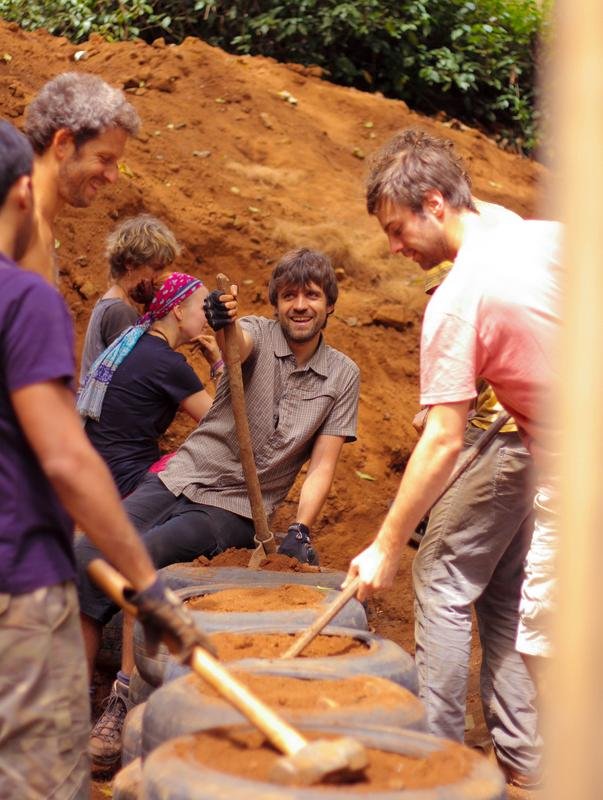
Launching a cob ball at the wall. Caution, can lead to mud fights!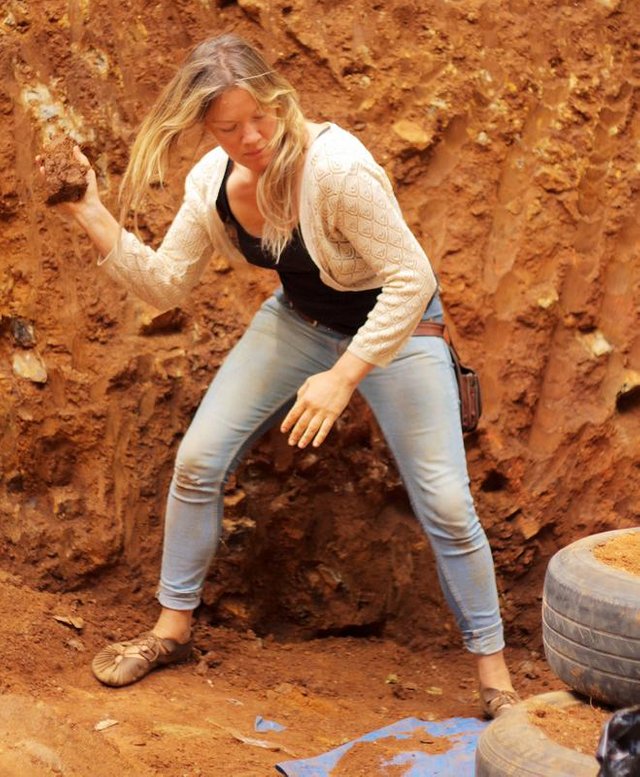
@nature-jon explaining the theory of Earthship construction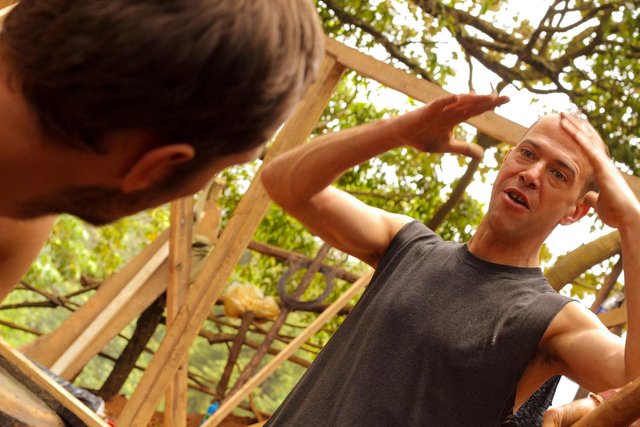
So easy a child can do it, no problem! Watch your toes! =)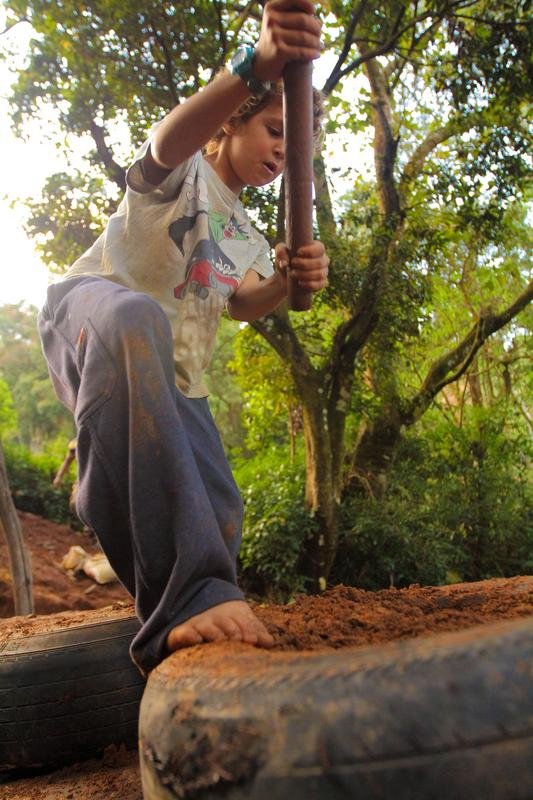
@nature-jon and I hatching a plan!
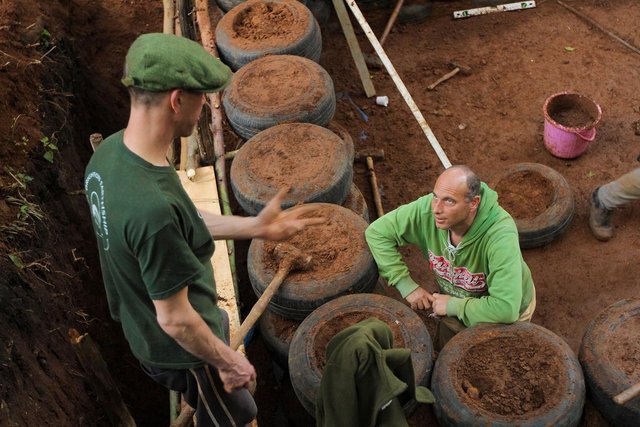
I just love her T-Shirt!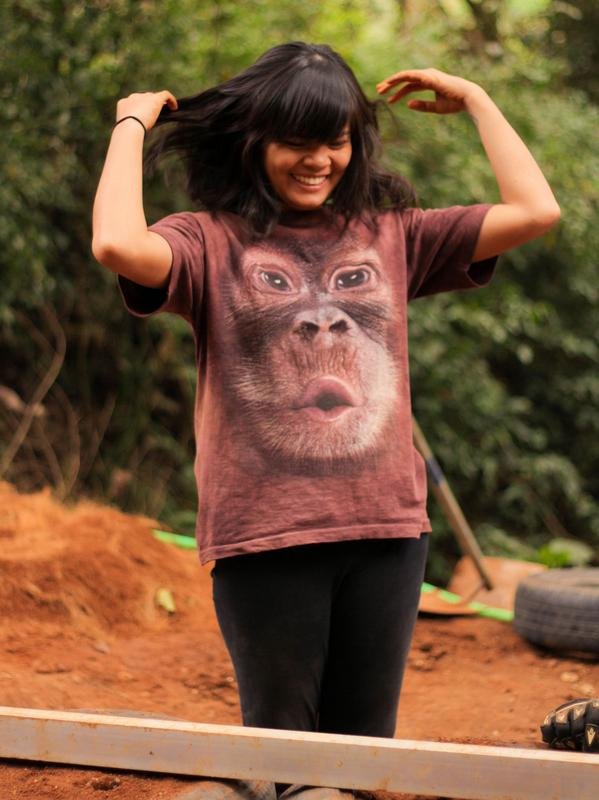
Whilst you are doing all of this pounding you are also checking the level of the tyre. It needs to be sitting dead center and not an inch or two more on one side. This means that the wall will stand straight up and won't lean over and topple! If you are burying your walls then you will lean the back wall slightly backwards into the dirt berm, in which case you do step each layer back about an inch. The height of the tyre also needs to be the same as the tyres next to it so that each level is one uniform height. We do this using string that is tied next to the walls so we can compare the levels. You can easily add or remove height from a tyre by adding more dirt and even stones, or tamping it down if it is too high.
In this way you can build these walls using many unskilled people and really very quickly. The conditions were tough on this workshop, and we had rains and total mist for days on end. Despite this, we managed to continues working although it did slow us down a bit.
Now Please Watch What I have just said happen by the magic of youtube!
@nature-jon just helped build the first domestic Earthship in the UK, called Earthship Sheppey. He was a HERO because they didn't get enough volunteers and single handedly pounded at least half the tyres of a big home. He is living proof that a small group of determined people can pull this off.
Once you get past the first few layers of tyres you can already start filling in the gaps on the inside and outside of the wall with cob. Cob is mixture of mud, straw (we used coconut hair), and water. It works best when there is some clay content in the soil, but can be done with pretty much any kind of dirt.
Here you can see a volunteer throwing a ball of cob at the gaps
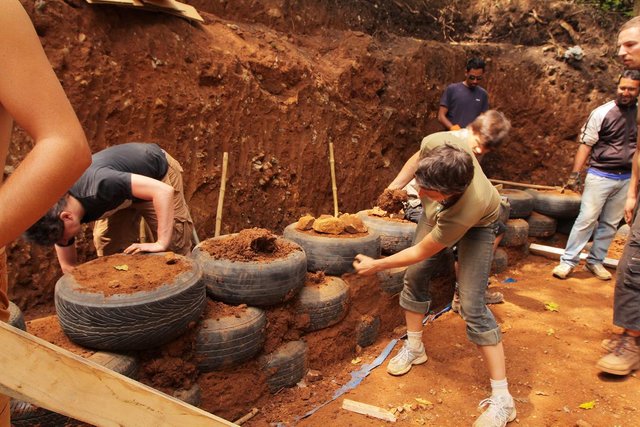
We had several children join us for this build including some of the kids who lived at Karuna at the time. They helped us so much, and also learned a lot themselves. This is home-schooling at its best folks!


Whilst all this was going on, a small team of us set to work getting the window frames and door frames set up. When you build an Earthship you can install the frames in place very early on and prop it up with sticks. This allows you to build the frame into the wall, and anchored to the tyre wall foundation below it. This process does need some skilled labour, mainly a carpenter and maybe a maisoner. We were fortunate to have more than one, with @nature-jon being an exceptional carpenter and yurt builder amongst other things. We had all the skills we needed, and for free because we had invited people to share each others time, labour and knowledge. When you do things this way, you not only save a lot of money, but end up working with people who have their hearts in the job, and that makes everything turn out so much better!
Setting up the window frame with a tar sheet to protect it from dampness.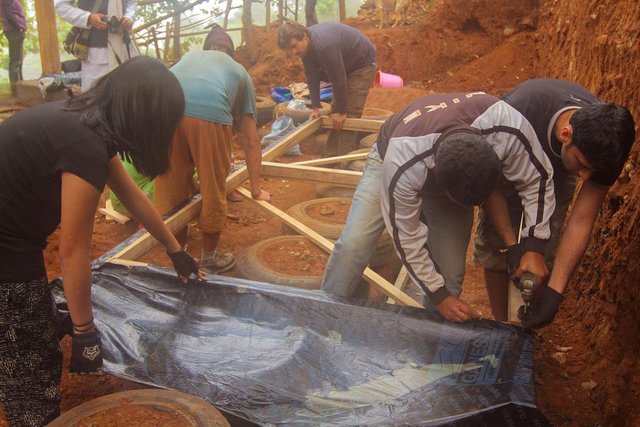
Uri keeping an eye on us and soaking it all up like a sponge!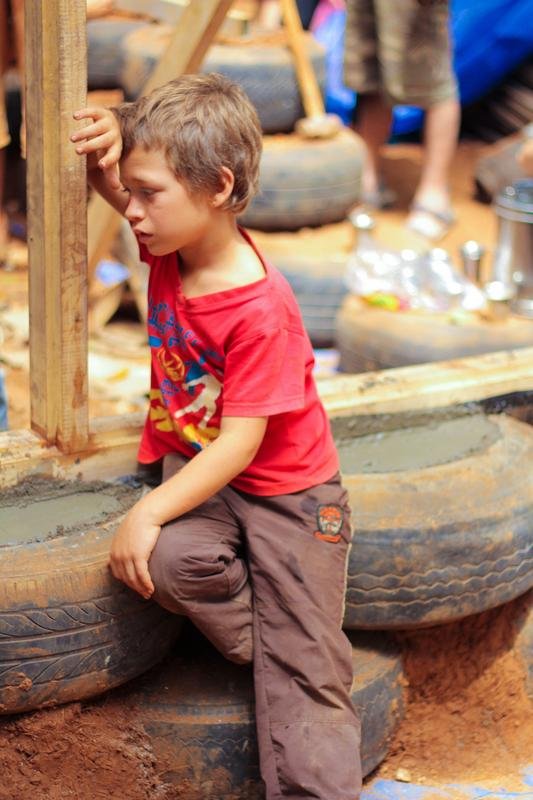
So I hope you can see that in the spirit of co-operation and open sharing we has a fantastic time and made great progress even in the first few days! I hope i have been able to inspire you and demonstrate that you can self build if you do it with help and a well intentioned group. There are SO many people wanting to build, but so few actually building. The only way is to Just Do It! Start small, make a test in your yard or for a friend and learn from that. Then one day you can perhaps join a group of people who want to do the same and work together to help build each others dreams!
I hope to be able to create an Earthship community one day, and am currently saving up so that I can make this happen at very low cost for others to own. This is what I am doing with my rewards and all my cryptocurrency investments. I hope that one day this dream of mine will be possible!
Thanks for being here with me and the #ecotrain!
We are a small community that support each other because we love what we write
about things that help make the world a better place

check our our ecoTrain magazine at @ecotrain
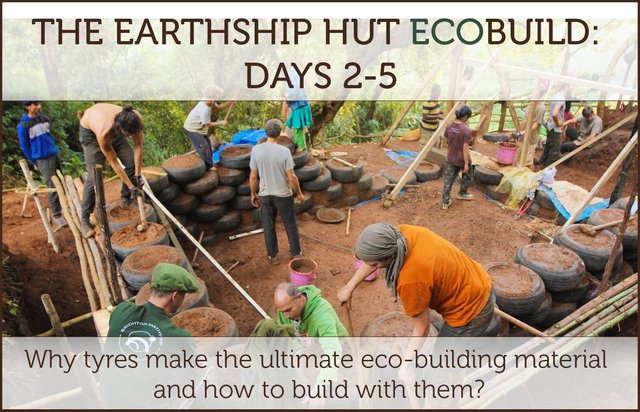
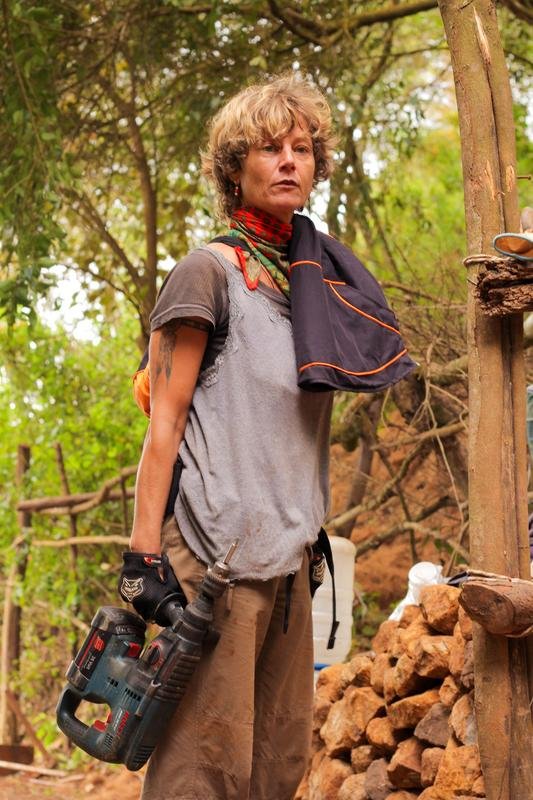

Wow gorgeous gorgeous photos!! Great Detail in the explanation @eco-alex! Really well done.
Especially Love this, so so important to understand thermal mass <3
"Every tyre you pound today is another 10 kilos of wood you don't have to chop tomorrow, or money you have to earn in order to pay for power bills! This is not only your house, but also your heating and cooling system for life!"
im happy you read this one, you are one of the few who knows these details, so coming from you this is nice to hear! no one has much clue what thermal mass is Vs insulation and that is a shame since it is one of the great benefits of Earthship Biotecture!
Wonderfully enthousiasming if that is even a word. Shall we build one? ;-)
anOther one, Yes sure! where u want to do it?!
In the beautiful place on earth we will find, where we are both comfortable, at home, connected, happy and healthy. <3
Great post! I was looking around for more Earthship builds in India but surprisingly found very few! I live in Sweden but originally belong to Assam in the North East so I was wondering what kind of build will suit a climate with high humidity and lots of rainfall. It's my dream to build and live in an Earthship someday and hopefully educate people along the way on the issues of sustainability and conservation.
Hope to visit Karuna some day! Best wishes and keep these great posts coming!
thanks a lot milwac! You are right, there are VERY few eco build or Earthship builds happening in India, and indeed wordwide right now... hopefully things will pick up as time goes on! im doing my best to promote this!
If you are building in high humidity you need to ensure you have enough skylight ventilation happening, and opening windows front in the greenhouse area if you have one.. You might also use a fan to help blow out hot humid air if you are in a very humid climate.. That combined with cooling tubes should help a lot!
Tires really are an excellent building block. It keeps the earth in, and all the things that would effect the earth out.
The only downside is if you do not like the bumpy mud inner wall surface, it is quite a bit more work to do anything else. But, you could always put firring strips and sheet rock just like a "normal" house and no one would ever know.
Yeah, I think if you build an earthship part of the charm are the bumps in it! ;-)
yup that is true.. including real bad pests like termites! I have tested that in a termite forest!
I opted for the bumpy finish on mine, saved a ton of work! And yes you can finish it in any way you like.. most people who visit my Earthship can't imagine there are tyres behind the mud plaster, even when I tell the they're there!
good job...
Like this post soo much that I followed you and resteem this post.
You guys are genius. Love your work. Well done everyone.
Wao we would take this step
Do you do a lot of earthships in northern climates?
Or are yours just built local to where you live?
i dont build much at all these days, but i have been a part of builds in the UK
Oh nice!
Was wondering if you knew too much about building in Canada.
Had no idea what earthships are till i read your post.
Heard about them lots but you'd think i'da done a google search.
Nope!
Dummy up!
Haha.
Now I'm curious to know how building one would fare well here.
oh theres Tonnes going on in canada,, yes please google it and also look for the Valhalla Movement
Valhalla movement heh?
This sounds super interesting!
I'll go check it out :)
Thanks!
@wwf built and lives in one in central/northern alberta
yup. he's been at -35!! and quite ok ;-)
He's a friend of mine! I've seen him talk about earth ships, but never asked. XD
Felt like a dummy.
Should have just pulled my big girl panties up and asked!
So much respect for you guys doing that!